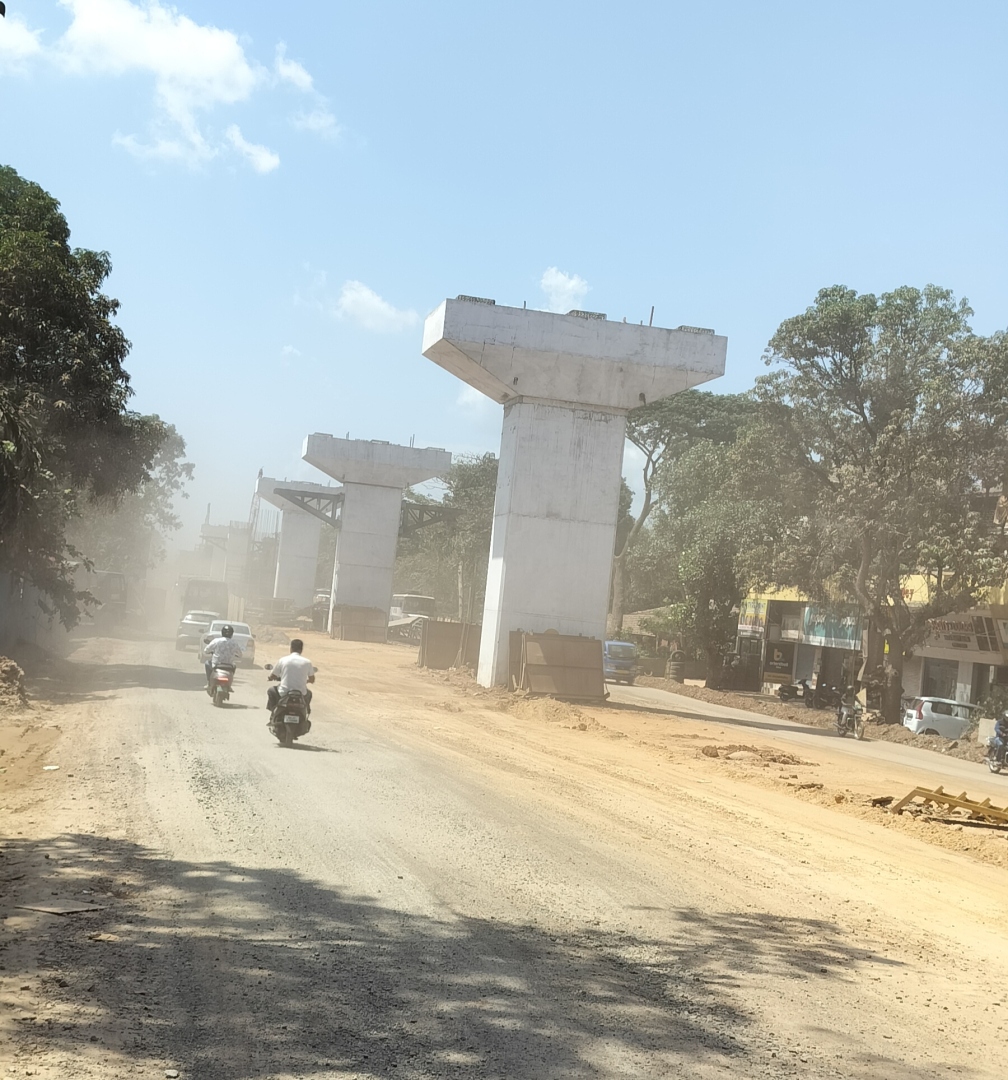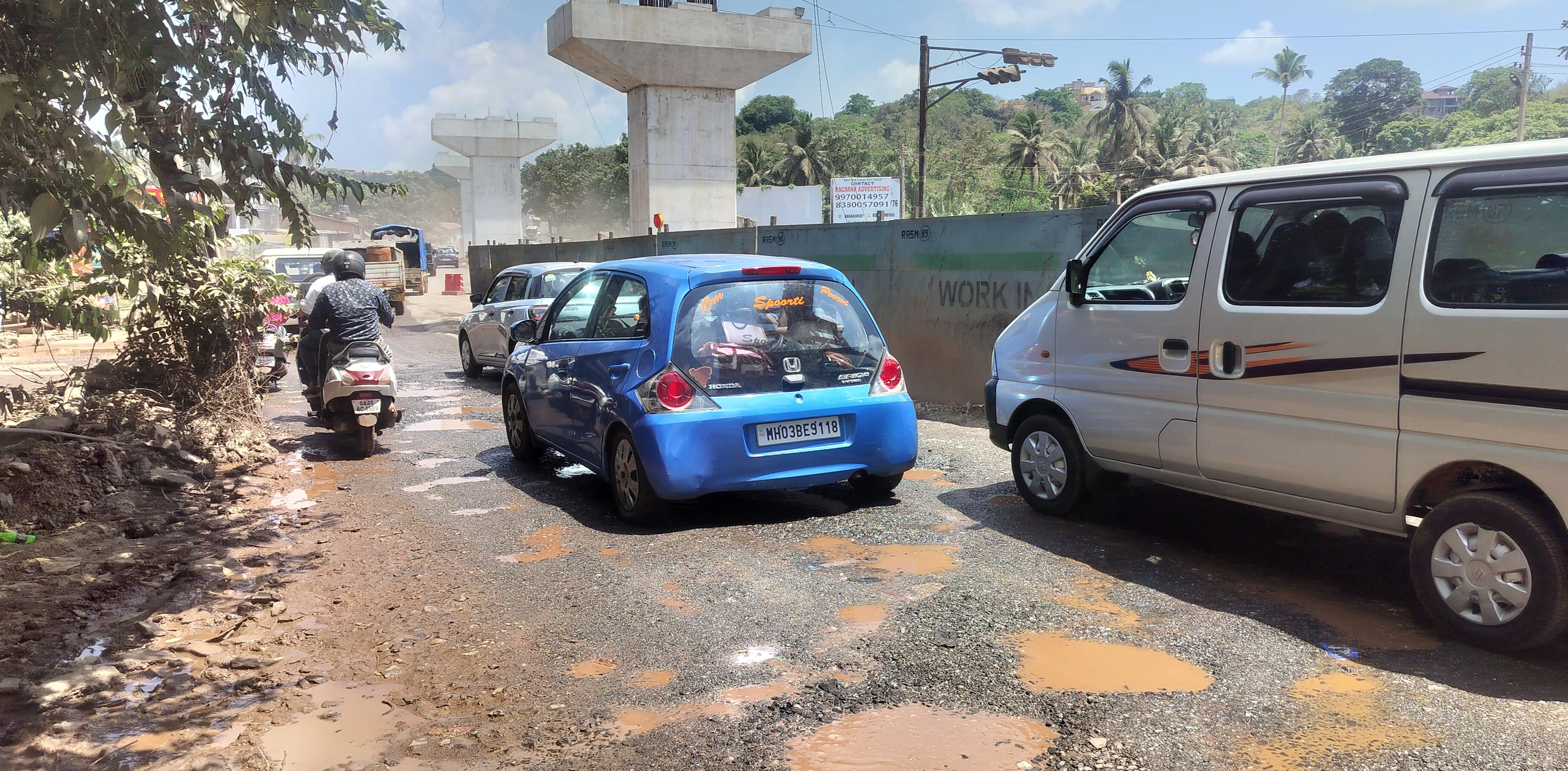
DUSTY TRAIL: Thick dust clouds from the NH-66 elevated corridor construction engulf the area, making daily life miserable for commuters, local residents and businesses.
Photo Credits: Agnelo Pereira

MAPUSA
A ride through the service roads of NH-66, from Sangolda junction to O’Coqueiro, has become nothing short of a daily ordeal for hundreds of motorists and commuters caught in the chaos of the ongoing elevated corridor construction.
What was once a bustling thoroughfare and part of NH-66 is now a hazardous stretch lined with potholes, loose gravel and a near-constant haze of dust – turning every journey into a test of patience and endurance.
The nearly two-kilometre ride through Porvorim’s service roads feels like a gauntlet.
With every passing bus, trailer or SUV, thick plumes of fine dust erupt into the air, coating everything – people, vehicles, shops and homes – in a gritty film.
Two-wheeler riders, in particular, are the worst hit.
“The dust pollution has made life miserable for us. We have to keep our doors and windows closed all day, but the fine dust still gets in. Our elderly family members are the worst affected,” said Pritam Naik, a resident living along the route.
Even more dangerous than the dust are the treacherous road conditions. Potholes and broken stretches force motorists to slow down suddenly, creating bottlenecks and triggering long, winding traffic jams.
In some places, loose gravel has made riding risky, especially for two-wheeler riders trying to navigate the narrow lanes.
In one particularly troubling incident, an ambulance was seen trapped in a jam near the Sangolda junction, its siren wailing in vain.
“For us, this is an everyday battle. Swallowing dust, dodging potholes and crawling in traffic has become the norm. Life has become incredibly difficult,” said Anthony D’Souza, who rides a two-wheeler to work daily.
The impact of the construction has also rippled through the local business community.
Majibul Ansari, who runs GM Tyre Point, a second-hand tyre shop along the stretch, lamented a steep drop in business.
“We’ve seen at least a 50% loss in sales since the work began. Earlier, they used to sprinkle water regularly to keep the dust down, but that has almost stopped now,” Ansari said.
The manager of Cuts and Colours, Pooja, a nearby hair salon, echoed her concerns.
“People don’t want to come here anymore. The dust is terrible, and access has become difficult. This time of year we usually see a holiday crowd, but now the place is almost empty,” she said.
Part of the problem lies in the narrowing of the service roads due to the construction, particularly near the landing point at Sangolda junction.
The constriction has reduced road width on both sides – traffic moving towards Panaji or moving from Panaji to Guirim – leading to unavoidable bottlenecks and more congestion.
Yet, amidst the frustration, there is a glimmer of hope.
Work on hotmixing certain stretches of the service roads has begun, albeit sporadically and at night due to the heavy traffic during the day.
Executive Engineer of PWD (NH) Jude Carvalho assured that the contractor has been instructed to prioritise drainage and road surfacing work.
“The work is progressing at top speed. We are working nights to finish the hotmixing. The plan is to complete it before the monsoon hits,” said Carvalho.
He also informed that by late June or mid-July, service road access from the new bypass to O’Coqueiro Hotel will be shut temporarily to facilitate launching of the segments, with traffic rerouted via ChogM Road and the new bypass.
But for now, daily commuters have little choice but to endure the harsh reality. Every journey is not just an inconvenience – it is a dust-filled, slow-moving, spine-jarring test of perseverance.
As the monsoon clouds begin to gather, residents and motorists alike can only hope that the construction keeps pace. Because if the situation is this bad now, what awaits in the rains might just be worse.